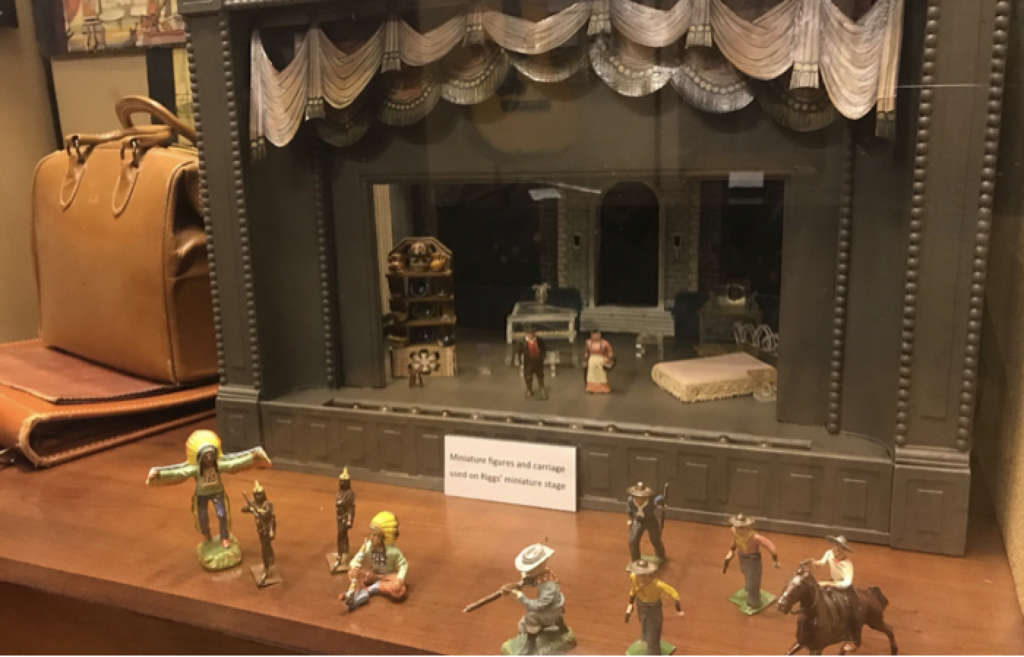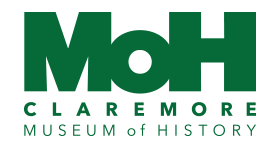
3rd Grade – Oklahoma History: Lynn Riggs and Playwriting Curriculum
Overview:
Third grade students will learn about the Broadway musical and film, Oklahoma! and Lynn Riggs, the creator of Green Grow the Lilacs. This program will meet third grade Oklahoma Academic Standards in English Language Arts, Visual Arts, Music, and Social Studies. The showcase artifact for this specific program will be Lynn’s miniature stage and the program will focus on creating a story.
Summary:
The artifacts that students will learn about for this specific program will be the Surrey with the Fringe on Top from Oklahoma! as well as Lynn’s miniature stage and figures. These artifacts were chosen for this program because third grade students can relate to playing with toys. Through this relevant relation students will learn about playwriting through their previous knowledge of their own favorite characters and toys. Educational artifacts will be provided for object-based learning. Students will learn new vocabulary that will relate to the overall lesson. Each student will be given a journal to write their own play and draw their own backdrops. The ELA (English Language Arts) and visual arts activity is called, Who? What? Where? and will inspire students to create a story and draw their own setting while learning about playwriting. The Surrey with the Fringe on Top, will be shown via SmartBoard and students will discuss what a surrey is and its importance in state history. A post-visit activity on creating their own miniature stage from household items will be provided.
90 Minute Program BREAKDOWN:
10 minutes: Welcome and Introduction
Who? Museum Director/Curator
What? is the MoH
Slides of Museum via SmartBoard(Interior/Exterior)
Where? Is the Museum
Slides of Gazebo Park via SmartBoard
(This introduction questions are set to establish the theme of the program’s main activity and objective.)
15 minutes: Lynn Riggs/Oklahoma State Song
- Watch Surrey with the Fringe on Top scene and from Oklahoma! from youtube via SmartBoard. Discuss state song.
- Clasroom Discussion on the importance of the artifact, the surrey at the MoH.
- Introduce Lynn’s miniature stage artifact, image handout.
Who? Is Lynn Riggs
What? Is Green Grow the Lilacs? And What? Is our state song?
Where? Is Lynn Riggs From
20 minutes: Vocabulary
Who?
CHARACTER: who the actor pretends to be. (Characters want things. They have goals and objectives.)
Ask students who their favorite characters are.
BIOGRAPHY: a character’s life story that a playwright creates.
Ask students what they know about their favorite characters.
What?
DIALOGUE: a conversation between two or more characters.
SCENE: a single situation or unit of dialogue in a play.
CONFLICT: obstacles that get in the way of a character achieving what he or she wants. What the characters struggle against.
MONOLOGUE: a long speech one character gives on stage.
PLOT: the structure of a play, including exposition, rising action, climax, falling action, and denouement.
CLIMAX: the turning point in a plot.
Ask students
what their favorite story is. This could be from a movie, cartoon, theatrical
play, or book.
Where?
SETTING: time and place of a scene.
Ask students where would their story take place and why.
15 minutes: Toys/Figures
Discuss what the difference between an educational artifact and an artifact.
Introduce post-visit activity build at home miniature stage.
(This allows students to continue the activity at home.)
30 minutes: Who? What? Where?
Playwriting project with MoH Journal
Supplies
Educational artifacts
Toys (action figures, toy animals, toy vehicles)
Miniature Stage
Markers and Crayons
Pencils
Journals
Stickers
OKLAHOMA ACADEMIC STANDARDS ACHIEVED
ELA (English Language Arts)
3.1.R.1 Students will actively listen and speak clearly using appropriate discussion rules.
3.1.R.2 Students will ask and answer questions to seek help, get information, or clarify about information presented orally through text or other media to confirm understanding.
3.1.R.3 Students will engage in collaborative discussions about appropriate topics and texts, expressing their own ideas clearly in pairs, diverse groups, and whole class settings.
3.1.W.1 Students will report on a topic or text, tell a story, or recount an experience with appropriate facts and relevant, descriptive details, speaking audibly in coherent sentences at an appropriate pace.
3.2.PC Students will correctly form letters in print and cursive and use appropriate spacing for letters, words, and sentences.
3.2.R.3 Students will summarize events or plots (i.e., beginning, middle, end, and conflict) of a story or text .
3.3.R.2 Students will infer whether a story is narrated in first or third person point of view in grade-level literary and/or informational text.
3.3.R. Students will find textual evidence when 3 provided with examples of literary elements and organization: setting (i.e., time, place), plot, characters, characterization, theme.
3.3.W.1 NARRATIVE
Students will write narratives incorporating characters, plot, setting, point of view, and conflict (i.e., solution and resolution).
3.3.W.2 INFORMATIVE
Students
will write facts
about
a subject, including a main idea with supporting details, and use transitional
and signal words.
3.3.W.3 OPINION
Students
will express an opinion about a topic and provide reasons as support.
3.4.W.1 Students will use domain-appropriate vocabulary to communicate ideas in writing.
3.4.W.2 Students will select appropriate language according to purpose in writing.
3.6.R.1 Students will use their own questions to find information on their topic.
3.6.R. 2. Students will use graphic features including photos, illustrations, captions, titles, labels, headings, subheadings, italics, sidebars, charts, graphs, and legends to define a text.
3.6.R.4 Students will determine the relevance and reliability of the information for their specific topic of interest with guidance and support.
3.6.W.1 Students will generate a list of topics of interest and individual questions about one specific topic of interest.
3.7.R.2 Students will compare how ideas and topics are depicted in a variety of media and formats.
3.8.W Students will write independently over extended periods of time (e.g., time for reflection and revision) and for shorter timeframes (e.g., a single sitting or a day or two) to communicate with different audiences for a variety of purposes.
GENERAL MUSIC
Standard 2: Music History and Culture – The student will recognize the development of music from an historical and cultural perspective.
1. Sing and perform action songs, chants, rhymes, singing games and dances from a variety of cultures.
2. Recognize music from our country, work songs, holiday songs and music from different countries.
SOCIAL STUDIES
History Literacy Content Standard 4: The student will analyze the significant events and historic personalities contributing to the development of the state of Oklahoma.
4.2 Read and interpret primary sources related to key in Oklahoma’s past to demonstrate understanding of the state song, Oklahoma.
VISUAL ARTS
Standard 1: Language of Visual Art – The student will identify visual art terms (e.g., collage, design, original, portrait, paint, subject).
- Use appropriate art vocabulary.
4. Use the elements of art and principals of design to express original ideas.
Standard 2: Visual Art History and Culture – The student will recognize the development of visual art from an historical and cultural perspective.
1. Understand that art reflects and describes the culture of its origin.
2. Identify connections between different styles of visual art and other art disciplines.
3. Identify specific works of art produced by artists including European, American, Native American, African American, Hispanic, and Asian art produced at different times and places.
Standard 3: Visual Art Expression – The student will observe, select, and utilize a variety of ideas and subject matter in creating original works of visual art.
1. Experiment in color mixing with various media.
2. Use a variety of subjects, basic media and techniques in making original art including drawing, painting, weaving, sculpture, printmaking, and ceramics.
3. Demonstrate understanding and knowledge of composition using the elements of art and principles of design.
4. Use art media and tools in a safe and responsible manner.
Standard 4: Visual Art Appreciation – The student will appreciate visual art as a vehicle of human expression.
1. Demonstrate appropriate behavior while attending a visual art exhibition in a museum or art gallery.
2. Demonstrate respect for personal artwork and the artwork of others.
3. Demonstrate thoughtfulness and care in completion of artworks.
